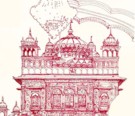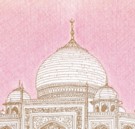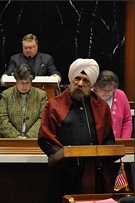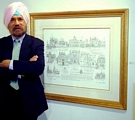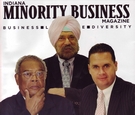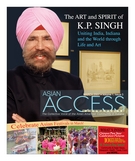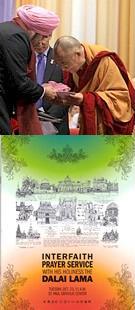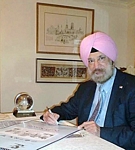God has no country, dress, form, limit or hue; God is omnipresent; God’s love is everywhere. There is one God. Eternal truth is God’s name; Maker of all things.
| Japji Sahib – morning prayers |
Throughout history, faith communities have challenged authority, awakened social conscience, fought tyranny and made sacrifices to safeguard the sanctity of their religious traditions. Sikh faith, the fifth largest religion with 25 million followers worldwide, makes its own unique contributions to the “Tapestry of Faiths.”
In Sikhism, Waheguru, the Wonderful Lord, is the Father of all Creation. God is the fountainhead and inspiration of all languages and all faiths, the benevolent sustainer of all life. No one is higher or holier because of caste, color, creed, nationality, gender, or station in life. Sikhs are reminded in their sacred texts that, “all life has originated from the same source of Light” and “every living being is a repository of Divine Light;” therefore, “recognize all humanity as one race, one brotherhood.” The doctrine of spiritual oneness of God and humanity resonates throughout the Guru Granth Sahib (Sikh holy scripture) and other Sikh sacred texts. The faith teaches that “God has no country, dress, form, limit or hue; God is omnipresent; God’s universal love is everywhere” (Jaap Sahib-a morning Sikh prayer).
The Sikh sacred texts teach that “God is the source of all Light and that Light illumines all Creation.” It is unconscionable to discriminate against anyone on the basis of one’s religion. All paths lead to the same “Center.” The Sikh faith recognizes the equality, dignity, and sovereignty of the entire spiritual community. One Supreme Spirit guides our temporal and spiritual destiny and “none now is our foe nor a stranger, with all we are in accord.” God has no boundaries, but humans create boundaries and limits to understand and define “the unfathomable and limitless Creator.” Each faith offers its own Divine perspective, inspirations, traditions, and unique cultural and spiritual thresholds.
In the seventeenth century the Mughal ruler of India, Emperor Aurangzeb, began a systematic persecution and forced conversion of Hindus to Islam by the thousands. Those who resisted perished. The Hindu religion was threatened; its way of life and peace shattered. In desperation, a delegation of frightened Kashmiri pandits (Hindu religious leaders) led by Kirpa Ram arrived at the spiritual court of the Ninth Sikh Guru, Teg Bahadur, at Anandpur Sahib, Punjab. The pandits related tales of horror and of grave danger to their religion, sacred places, and people. They sought the Guru’s wise counsel and intervention to save them from this campaign of oppression and persecution. The Guru realized the gravity of the situation and the dangers of confrontation with the Emperor. He told the Hindu leader that he could inform the Emperor that the Sikh Guru Teg Bahadur was the spiritual leader of the Hindus and that if he, the Guru, were persuaded to embrace Islam, then the Hindu community would accept the Muslim faith without further resistance.
The Guru was immediately summoned to the Mughal royal court at Delhi, imprisoned and tortured. The Guru said to the Emperor during their “meetings” that forced conversion was a moral outrage. The freedom to practice one’s faith was a God-given right and the State had no right to interfere with people’s peaceful spiritual associations and faith traditions. The Guru reminded Aurangzeb that he was the Emperor of all his subjects who follow many religions. The angered Emperor first tortured and killed three of the Guru’s disciples in front of him and then gave him the choice to either accept Islam or face death. The Guru refused to surrender and fearlessly accepted death rather than abandon his commitment to a sacred principle.
The Sikh Guru was beheaded on 11th November, 1675 at Chandni Chowk, a public square in Old Delhi, defending the honor of the Hindu faith and upholding the right of all to embrace, worship and celebrate their faith in total freedom. Today, there is a Sikh Temple, Gurudwara Sis Ganj at the site of his martyrdom, a place of solemn Sikh pilgrimage. The Sikhs draw strength and inspiration from this sacred symbol of resistance to oppression, a shrine commemorating the supreme sacrifice of the Divine Prophet of the Sikh faith for the cause of another faith. This is hallowed ground. Many historians believe that the Guru’s death may have saved India from becoming a total Muslim State. His martyrdom set in motion events that changed the course of Indian history.
Although the Sikh tradition had broken from Hinduism, Guru Teg Bahadur’s remarkable deed honored the Hindu tradition and thus preserved the integrity of the Sikh faith. Sacred scriptures, traditions, a universal spirit and seva (selfless service) define the cherished boundaries of this unique Sikh faith. The defense of the sacred borders of other faiths and cultural traditions has been an honored commitment in Sikhism since its founding in 1469. Sacred texts counsel that in “matters of conscience,” a “righteous fight and supreme sacrifice” is the way to live the faith and to honor the Guru and the Wonderful Lord.
Guru Gobind Singh, the Tenth and last Sikh Guru, in his autobiography, Bachittar Natak (the strange drama), wrote about the supreme and extraordinary sacrifice of his father, Guru Teg Bahadur, in defense of Hinduism and a universal sacred right: “He protected the tilak (sacred forehead mark) and the janeau (sacrificial thread) of the Hindus and performed an incredible noble deed in Kal Age (the present Age). “He further wrote “The world cried in horror over his death, but the gods in heaven rejoiced that the victor returns ‘Home’ in triumph.”
Guru Teg Bahadur symbolically and literally crossed a spiritual boundary to uphold a principle. The Sikh fight was against tyranny of rulers who sought to invade the boundaries of others. There was no malice towards Islam or any other faith. The Sikh founder, Guru Nanak, proclaimed, “There is one God. Eternal Truth is God’s Name; Maker of all things.” (Japji Sahib, morning prayer).
Guru Nanak sought to unify the Hindu and Moslem communities. He studied Eastern and Western faiths during his extended travels to the religious centers in the Middle East, Russia, China, Tibet, and throughout India in the early sixteenth century. The fifth Sikh Guru, Arjan Dev, completed the Guru Granth Sahib (Sikh holy scriptures). This extraordinary poetic treasure enshrines sacred writings of Muslim and Hindu saints alongside the compositions of the Sikh Gurus. The foundation stone of the Indo-Saracenic (architectural style) Golden Temple, the St. Peter’s and the Mecca of the Sikhs, was laid by Moslem saint Hazrat Mian Mir in 1588. Under its “golden domes” reverberates an unmistakable message of unity, equality and the sovereignty of all faiths.
A Sikh sees every living being as worthy of God’s love and human compassion. A Sikh feels “kinship of spirit” with all and no one is “outside the circle of universal spirit.” The Sikh scriptures present a limitless view of the temporal and celestial universe and reject all divisive and separating walls created by faith leaders and religious zealots for personal gains and glory. For Sikhs, Kirat Karni (honest labor), Vand Chhakna (sharing with others), Naam Japna (remembering God) and Seva (selfless service) are the true foci of a faithful life. Our daily recitation and meditation of Jaap Sahib (sacred text) affirm, ” To love God is to love all Creation. Every act of service is an offering to God.” Sikh history is a living witness to the countless sacrifices made for worthy causes and communities outside its own.
As an act of our common humanity, we must safeguard the dignity of all God’s children. Injury to the civic or spiritual rights of even one soul is an affront to human decency everywhere and to God who loves us all. Inaction on the part of people of goodwill may encourage continued aggression, embolden the oppressor and repeat the long nightmares of the past. Guru Teg Bahadur reminds us that it is an act of faith to stand united in spiritual and human solidarity in the face of evil. The sacrifices of pious souls like Guru Teg Bahadur set before us an example of extraordinary dimension: physical, cultural, and spiritual differences must not stop us from doing the right thing. We must be prepared to cross the temporal and spiritual boundaries to defend the fundamental freedoms and rights of all people. Guru Teg Bahadur’s martyrdom stands as testimony to the sanctity and human dignity of every person regardless of that person’s faith. Although the Hindu faith had traditions and doctrines different than his own Sikh faith, he, nonetheless defended its honor.
Imagine crossing and traversing boundaries as a bridge to a more enlightened and peaceful world where unity of purpose, equality of opportunity, sanctity of all faiths, dignity of each individual, and justice for all are enshrined as the “Universal Commandments.” No sacrifice is too great to safeguard them, and no one is left outside this universal circle of hope and basic dignity. Sikhs remember the saintly Teg Bahadur in the daily Ardas (prayer of supplication) and celebrate his life. Now the world does too; the United Nations recognizes him as a great champion of human rights.
The spirit of selfless sacrifice of Guru Teg Bahadur in 1675 continues to inspire us to create a world where right actions, not fear, shape human destiny, where tolerance and understanding reign supreme. He challenges us to transcend diverse faith traditions, ethnic and cultural divides, and bridge a message of hope to unfamiliar lands and communities still yearning to triumph in their battles and struggles for freedom of thought, spirit and conscience. May each of us live the true essence of our sacred texts by respecting the faith of others.
at honor sacred writings of different traditions?
Kanwal Prakash “KP” Singh
Indianapolis, Indiana USA
January 1, 2005
